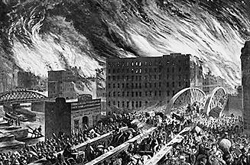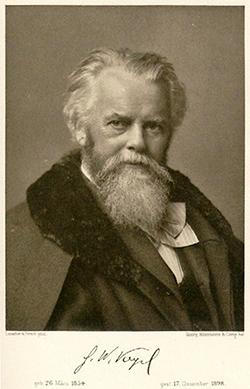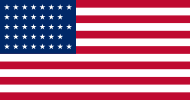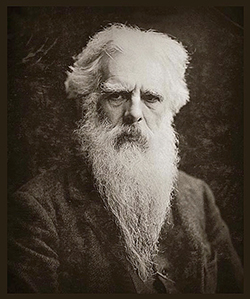MENU
The Electronic Scholarly Publishing Project: Providing access to classic scientific papers and other scholarly materials, since 1993. More About: ESP | OUR CONTENT | THIS WEBSITE | WHAT'S NEW | WHAT'S HOT
Comparative Timelines
The ESP Timeline (one of the site's most popular features) has been completely updated to allow the user to select (using the timeline controls above each column) different topics for the left and right sides of the display.
Select:
New Left Column
New Left Column
Dates
Decade
New Right Column
New Right Column
 Standard Oil Formed On January 10th, 1870, John D Rockefeller and four partners incorporate the Standard Oil Company. The company gains control of nearly 95% of the oil refining industry in the United States.
Standard Oil Formed On January 10th, 1870, John D Rockefeller and four partners incorporate the Standard Oil Company. The company gains control of nearly 95% of the oil refining industry in the United States.
The First Vatican Council of the Roman Catholic Church proclaims the dogma of the infallibility of the Pope.
The Franco-Prussian war (1870-71) leads to the formation of the German Empire.
1870
(no entry for this year)
 On October 8th, a fire broke out in the west side of Chicago. The Great Chicago Fire lasted two days, killing 300 people, and destroying most of Chicago. Property damages were estimated at 200 million dollars.
On October 8th, a fire broke out in the west side of Chicago. The Great Chicago Fire lasted two days, killing 300 people, and destroying most of Chicago. Property damages were estimated at 200 million dollars.
On October 8th, a fire broke out in the village of Peshtigo, Wisconsin. The Peshtigo Fire caused more deaths than any other fire in the history of the United States. By the time it was over, 1,875 square miles (1.2 million acres) of forest had been consumed, an area approximately twice the size of the state of Rhode Island. Some sources list as much as 1.5 million acres burned. Twelve communities were destroyed. An accurate death toll has never been determined since local population records were destroyed in the fire. Between 1,200 and 2,500 people are thought to have lost their lives.
The occurrence of this fire, and several other smaller fires, on the same day as the Great Chicago fire has lead some to speculate that all of the fires may have had a common cause: multiple impacts from fragments of a disintegrating comet.
Richard Leach Maddox invents the gelatin dry plate silver bromide process. Negatives no longer had to be developed immediately. Long before his discovery of the dry gelatin photographic emulsion, Maddox was prominent in what was called photomicrography - photographing minute organisms under the microscope. The eminent photomicrographer of the day, Lionel S. Beale, included as a frontispiece images made by Maddox in his manual 'How to work with the Microscope'.

 Henry Morton Stanley finds David Livingstone in Africa, greeting the Scotsman with the famous words, "Dr. Livingstone, I presume."
Henry Morton Stanley finds David Livingstone in Africa, greeting the Scotsman with the famous words, "Dr. Livingstone, I presume."
The Second Reich proclaimed With the German victory in France complete, the German Reichstag(parliament) proclaimed the creation of the Second Reich. The Reichstag approved with minor modification the constitution of the Northern German Federation. William I became King of Germany with Otto Bismarck the first chancellor.
1871
(no entry for this year)
(no entry for this year)
1872
(no entry for this year)
Slavery is abolished in Puerto Rico.
Spain decrees the end of slavery in Cuba, still a Spanish colony.
QWERTY keyboard invented
 Hermann Wilhelm Vogel discovers dye sensitization, allowing the blue-sensitive but otherwise color-blind photographic emulsions then in use to be made sensitive to green, yellow and red light. Technical problems delay the first use of dye sensitization in a commercial product until the mid-1880s; fully panchromatic emulsions are not in common use until the mid-20th century.
Hermann Wilhelm Vogel discovers dye sensitization, allowing the blue-sensitive but otherwise color-blind photographic emulsions then in use to be made sensitive to green, yellow and red light. Technical problems delay the first use of dye sensitization in a commercial product until the mid-1880s; fully panchromatic emulsions are not in common use until the mid-20th century.
1873
Slavery is abolished in Puerto Rico.
Spain decrees the end of slavery in Cuba, still a Spanish colony.
Thomas J. Watson Sr. is born
The first electric tram operates in New York City.
1874
(no entry for this year)
(no entry for this year)
1875
(no entry for this year)

 Ferdinand Hurter and Vero Charles Driffield begin systematic evaluation of sensitivity characteristics of photographic emulsions — the science of sensitometry. They also invent a photographic exposure estimation device known as an actinograph. In 1920, William Bates Ferguson edits a memorial volume: The Photographic Researches of Ferdinand Hurter & Vero C. Driffield: Being a Reprint of Their Published Papers, Together With a History of Their Early Work & a Bibliography of Later Work on the Same Subject.
Ferdinand Hurter and Vero Charles Driffield begin systematic evaluation of sensitivity characteristics of photographic emulsions — the science of sensitometry. They also invent a photographic exposure estimation device known as an actinograph. In 1920, William Bates Ferguson edits a memorial volume: The Photographic Researches of Ferdinand Hurter & Vero C. Driffield: Being a Reprint of Their Published Papers, Together With a History of Their Early Work & a Bibliography of Later Work on the Same Subject.
 Custer Killed at Little Bighorn On June 25th, in Dakota territory, at the Little Big Horn, General George Armstrong Custer (who graduated from West Point in 1861, last in his class) and all 256 troops were killed. The defeat of Custer in the Battle of the Little Big Horn was the last Indian victory.
Custer Killed at Little Bighorn On June 25th, in Dakota territory, at the Little Big Horn, General George Armstrong Custer (who graduated from West Point in 1861, last in his class) and all 256 troops were killed. The defeat of Custer in the Battle of the Little Big Horn was the last Indian victory.
 Alexander Graham Bell patents the telephone.
Alexander Graham Bell patents the telephone.
1876
(no entry for this year)
The Compromise of 1877 ends Reconstruction and gives the Presidency to Rutherford B. Hayes. Although Democratic presidential candidate Samuel Tilden won the popular vote, Southern Democratic leaders agreed to support Rutherford Hayes' efforts to obtain the disputed electoral votes of Florida, Louisiana, and South Carolina in exchange for the withdrawal of the last federal troops from the South and the end of federal efforts to protect the civil rights of African Americans.
 Rutherford B. Hayes becomes nineteenth president of the United States.
Rutherford B. Hayes becomes nineteenth president of the United States.
 The US flag is modified to have thirty-eight stars, reflecting the addition of one new state: Colorado.
The US flag is modified to have thirty-eight stars, reflecting the addition of one new state: Colorado.
Frederick Douglass becomes US Marshal for the District of Columbia.
 Phonograph Invented by Edison On December 15th, Thomas Edison applied for a patent for his phonograph. Edison initially believed it would be used to record business sessions, or family voices. Edison became famous with this invention and was invited to the White House for a demonstration.
Phonograph Invented by Edison On December 15th, Thomas Edison applied for a patent for his phonograph. Edison initially believed it would be used to record business sessions, or family voices. Edison became famous with this invention and was invited to the White House for a demonstration.
1877
The Compromise of 1877 ends Reconstruction and gives the Presidency to Rutherford B. Hayes. Although Democratic presidential candidate Samuel Tilden won the popular vote, Southern Democratic leaders agreed to support Rutherford Hayes' efforts to obtain the disputed electoral votes of Florida, Louisiana, and South Carolina in exchange for the withdrawal of the last federal troops from the South and the end of federal efforts to protect the civil rights of African Americans.
Frederick Douglass becomes US Marshal for the District of Columbia.

 Thomas Edison and Joseph Wilson Swan produce first successful incandescent electric light.
Thomas Edison and Joseph Wilson Swan produce first successful incandescent electric light.
Willgodt T. Odhner granted a patent for a calculating machine
 Eadweard Muybridge uses a row of cameras with trip-wires to make a high-speed photographic analysis of a galloping horse. Each picture is taken in less than the two-thousandth part of a second, and they are taken in sufficiently rapid sequence (about 25 per second) that they constitute a brief real-time "movie" that can be viewed by using a device such as a zoetrope, a photographic "first".
Eadweard Muybridge uses a row of cameras with trip-wires to make a high-speed photographic analysis of a galloping horse. Each picture is taken in less than the two-thousandth part of a second, and they are taken in sufficiently rapid sequence (about 25 per second) that they constitute a brief real-time "movie" that can be viewed by using a device such as a zoetrope, a photographic "first".
Heat ripening of gelatin emulsions is discovered. This greatly increases sensitivity and makes possible very short "snapshot" exposures.
 The world's first oil tanker — the Zoroaster — is launched, in the Caspian Sea. The ship was designed by Ludvig Nobel, the brother of Alfred Nobel.
The world's first oil tanker — the Zoroaster — is launched, in the Caspian Sea. The ship was designed by Ludvig Nobel, the brother of Alfred Nobel.
The first electric street lighting appears, in London.
1878
(no entry for this year)
 F. W. Woolworth opens his first "five and dime store".
F. W. Woolworth opens his first "five and dime store".
1879
(no entry for this year)
ESP Quick Facts
ESP Origins
In the early 1990's, Robert Robbins was a faculty member at Johns Hopkins, where he directed the informatics core of GDB — the human gene-mapping database of the international human genome project. To share papers with colleagues around the world, he set up a small paper-sharing section on his personal web page. This small project evolved into The Electronic Scholarly Publishing Project.
ESP Support
In 1995, Robbins became the VP/IT of the Fred Hutchinson Cancer Research Center in Seattle, WA. Soon after arriving in Seattle, Robbins secured funding, through the ELSI component of the US Human Genome Project, to create the original ESP.ORG web site, with the formal goal of providing free, world-wide access to the literature of classical genetics.
ESP Rationale
Although the methods of molecular biology can seem almost magical to the uninitiated, the original techniques of classical genetics are readily appreciated by one and all: cross individuals that differ in some inherited trait, collect all of the progeny, score their attributes, and propose mechanisms to explain the patterns of inheritance observed.
ESP Goal
In reading the early works of classical genetics, one is drawn, almost inexorably, into ever more complex models, until molecular explanations begin to seem both necessary and natural. At that point, the tools for understanding genome research are at hand. Assisting readers reach this point was the original goal of The Electronic Scholarly Publishing Project.
ESP Usage
Usage of the site grew rapidly and has remained high. Faculty began to use the site for their assigned readings. Other on-line publishers, ranging from The New York Times to Nature referenced ESP materials in their own publications. Nobel laureates (e.g., Joshua Lederberg) regularly used the site and even wrote to suggest changes and improvements.
ESP Content
When the site began, no journals were making their early content available in digital format. As a result, ESP was obliged to digitize classic literature before it could be made available. For many important papers — such as Mendel's original paper or the first genetic map — ESP had to produce entirely new typeset versions of the works, if they were to be available in a high-quality format.
ESP Help
Early support from the DOE component of the Human Genome Project was critically important for getting the ESP project on a firm foundation. Since that funding ended (nearly 20 years ago), the project has been operated as a purely volunteer effort. Anyone wishing to assist in these efforts should send an email to Robbins.
ESP Plans
With the development of methods for adding typeset side notes to PDF files, the ESP project now plans to add annotated versions of some classical papers to its holdings. We also plan to add new reference and pedagogical material. We have already started providing regularly updated, comprehensive bibliographies to the ESP.ORG site.
ESP Picks from Around the Web (updated 06 MAR 2017 )
Old Science

Weird Science

Treating Disease with Fecal Transplantation
Fossils of miniature humans (hobbits) discovered in Indonesia

Dinosaur tail, complete with feathers, found preserved in amber.
Astronomy

Mysterious fast radio burst (FRB) detected in the distant universe.